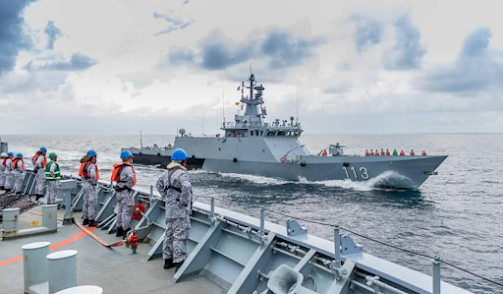 |
| Eight second batch of LMS vessels under construction (photos : TLDM) |
International Military - Malaysia has recently succeeded in strengthening its country's Navy. Malaysia is equipping the Royal Malaysian Navy (TLDM) with Littoral Mission Ships (LMS).
Recently, the second wave of TLDM Littoral Mission Ships (LMS) will be equipped with more sophisticated weapon systems. Defense Minister Hishammuddin Hussein confirmed that the second batch of LMS was more sophisticated than the first batch of four ships built in China.
At an event at the Ministry of Defense on Thursday April 14, 2022, the Defense Minister said careful planning to acquire the second group of three LMS ships (for starters) had been initiated by TLDM.
"MinDef (Ministry of Defense) has started seriously planning the implementation of the second wave of LMS procurement and will start with three LMS which will be equipped with more sophisticated defense equipment," he said as quoted by Defense Security Asia. which will complete the second batch of LMS ships.
Media reports during the recently concluded Defense Services Asia 2022 exhibition mentioned that the second batch of TLDM LMS vessels ranged in length from 85 meters to 100 meters. The maximum speed of this LMS Second Batch TLDM ship is 28 knots while its cruising speed is 14 knots.
As for weapons systems, the TLDM Second Force LMS ships will be equipped with a 57mm gun, 30mm Close-In Weapon System (CIWS) and two NSM anti-ship missile launchers developed by Kongsberg of Norway.
In addition, the second batch of LMS ships will also be equipped with low-range anti-aircraft missiles for point defense from any air attacks. The use of the Kongsberg NSM missile on the admin is precisely on the factor of similarity to the anti-ship missile system that will be used by six Littoral Combat Ship (LCS) ships.
At the 2022 DSA exhibition, several local companies in collaboration with their overseas partners showcased the design of the LMS Second Batch that will be offered to the Royal Malaysian Navy (RMN). Based on this design, the second batch of LMS vessels will weigh between 1800 tonnes to 2400 tonnes.
Companies from China, the Netherlands, Turkey and South Korea appear to be interested in supplying the Second Batch LMS vessels to RMN. TLDM Commander Admiral Tan Sri Mohd Reza Mohd Sany recently said his party plans to acquire three LMS vessels first in the Batch 2 LMS vessel procurement program.
TLDM is said to be planning to acquire up to eight second LMS Batch 2 vessels this year, with construction to be carried out in stages under the 12th Malaysia Plan (2021-2025). In January 2022, the Royal Malaysian Navy commissioned the fourth Keris-class Littoral Mission Ship (LMS), KD Rencong, for use at the Eastern Fleet Command headquarters in Sepanggar.
Quoted from The Star, the Commander of the Navy, Admiral Tan Sri Mohd Reza Mohd Sany, attended the inauguration ceremony on Friday, January 28, 2022. The new LMS will join three similar vessels, KD Keris, KD Sundang and KD Badik, as part of the 11 LMS Squadron which will operate out of the Eastern Fleet Command.
Admiral Mohd Reza said KD Rencong is one of four LMS obtained through the naval transformation program. "With the presence of LMS KD Rencong which is headquartered in Kota Kinabalu, I believe it will further enhance the capabilities of the Eastern Fleet together with other LMS ships," he told reporters after the inauguration.
In a statement, the navy said construction of the KD Rencong began on September 19, 2019 in Wuhan, China. The ship set sail on December 21 last year and arrived at the Sepanggar base on December 28, covering a distance of 1,811 nautical miles.
The KD Rencong has a speed of up to 22 knots, a length of 68m, a width of 9.20m and is capable of operating for 15 days without supplies. Admiral Mohd Reza said Malaysia plans to acquire a second batch of LMS to enhance naval assets and capabilities. "We hope that the second batch can be realized this year or next year," he said.
